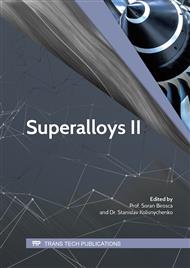p.1077
p.1083
p.1088
p.1095
p.1099
p.1105
p.1111
p.1117
p.1123
Yb: YAG Laser Welding of Aeronautical Alloys
Abstract:
Interest in the use of laser technology is growing in the aeronautical sector. The implementation of new Yb: YAG solid laser sources and new optical generations (dynamic focal length; 2in1 fiber: Fiber core and ring core) offers advantages in terms of quality, accuracy, reproducibility and weld dimensions. The LASER beam Yb: YAG of these new sources is generated, no longer from a bar of yttrium-aluminum garnet but from a disk. Moreover, a top-hat shaped power distribution and a top-hat shaped power distribution with a sharply limited recess in the center (ring structure) may be at the focal point using respectively the inner fiber and the coaxial fiber. These technological innovations offer new possibilities for cutting and welding of sheet metal parts. The welding domains of EN AW-6061 aluminum alloy, Commercial Purity Titanium - Grade 2 (T40), AISI 321 stainless steel alloy, nickel based Hastelloy X and Inconel 625 and cobalt based Haynes 188 superalloys are defined according to process parameters such as power density, focal diameter, welding speed and fiber type. Optimal welding parameters are determined for each alloy. The evolution of the microstructures and the mechanical properties of each zone of the welds are explained according to the power density, the heat input energy and the welding speed.
Info:
Periodical:
Pages:
1099-1104
Citation:
Online since:
December 2018
Authors:
Keywords:
Price:
Сopyright:
© 2018 Trans Tech Publications Ltd. All Rights Reserved
Share:
Citation:



